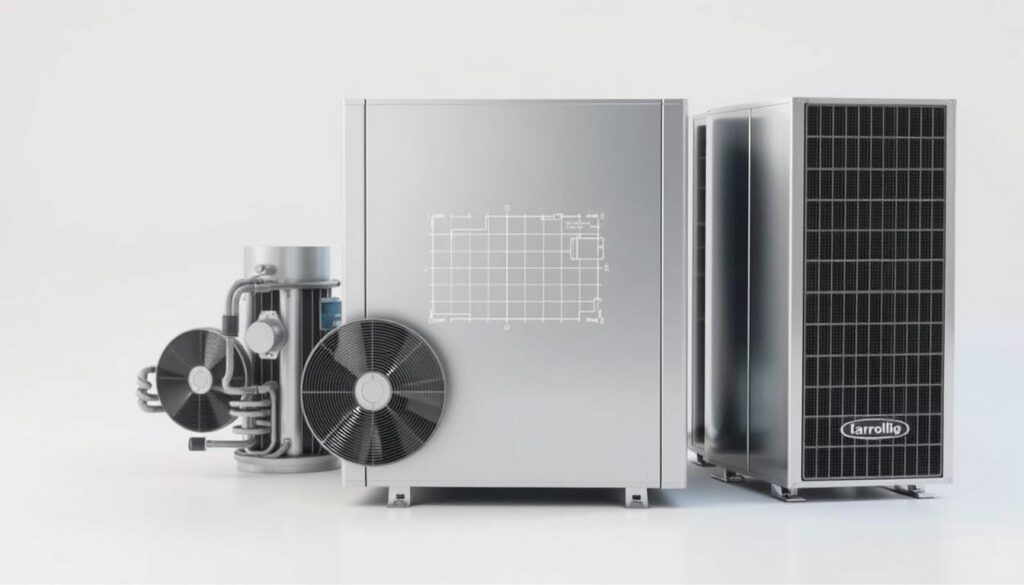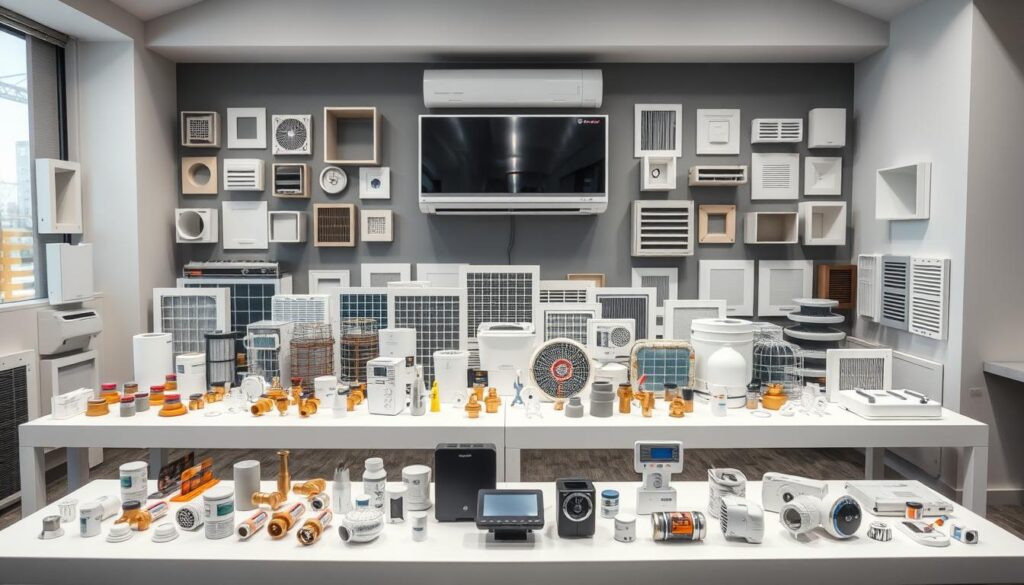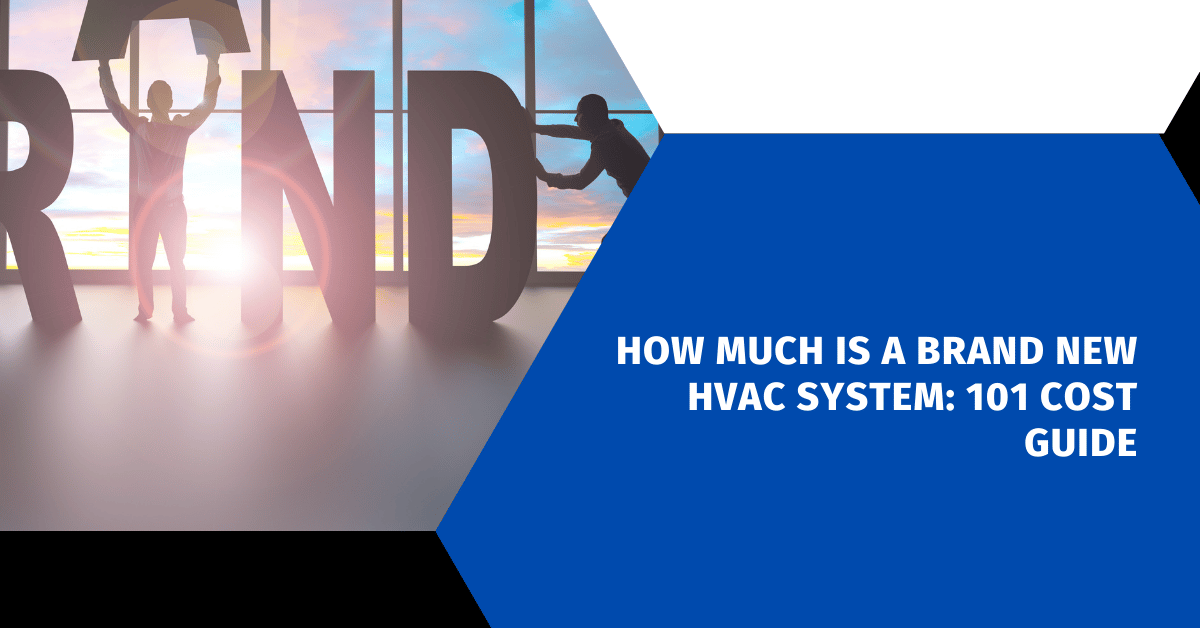Affiliate Disclosure
HVAC Guide Guys is a participant in the Amazon Services LLC Associates Program, an affiliate advertising program designed to provide a means for sites to earn advertising fees by advertising and linking to Amazon.
How Much Is a Brand New HVAC System? Ever wondered why HVAC costs can differ so much between homes? It’s not just about the price. It’s about investing in your home’s comfort and efficiency.

HVAC installation costs can be anywhere from $5,000 to $15,000. This depends on several important factors. Homeowners need to understand the costs of equipment, labor, and specific home needs. This guide will help you understand HVAC pricing better.
Whether you’re upgrading or getting a new HVAC system, knowing the cost is key. We’ll break down the costs for you. This will help you plan your budget better.
Key Takeaways
- HVAC system costs vary widely based on home size and complexity
- Professional installation is key for the best system performance
- Energy efficiency can greatly affect long-term costs
- Different HVAC types have their own pricing
- Proper sizing is vital for cost-effective cooling and heating
Table of Contents
Understanding HVAC System Basics and Components
When looking at residential HVAC system prices, it’s key to know the basic parts of your home’s comfort system. The cost of your HVAC equipment can change a lot, depending on the system’s complexity and type.
An HVAC system is more than one unit. It’s a complex network of parts that work together. They control your home’s temperature, humidity, and air quality.
Core Components of an HVAC System
- Outdoor unit (condenser or heat pump)
- Indoor unit (furnace or air handler)
- Thermostat and control system
- Ductwork for air distribution
- Air filtration system
Types of HVAC Units
Homeowners can choose from several HVAC systems:
- Split Systems: Most common setup with separate indoor and outdoor units
- Heat Pumps: Efficient for both heating and cooling
- Ductless Mini-Splits: Great for homes without ductwork
- Packaged Systems: All components in one unit
HVAC Component Lifespan
Knowing how long HVAC parts last helps with planning. Here are some typical lifespans:
- Air conditioners: 10-15 years
- Furnaces: 15-20 years
- Heat pumps: 10-15 years
- Thermostats: 10-25 years
This info helps you make smart choices about your HVAC system prices and when you might need to replace parts.
Explore Our HVAC Shop
Looking for top-rated HVAC tools, parts, and accessories? Visit our shop and find the perfect solution for your needs.
Visit the ShopHow Much Is a Brand New HVAC System: Complete Cost Breakdown
Knowing the cost of a new HVAC system is key for homeowners. The price can change a lot based on different factors. It’s important to look at each part carefully.
When looking at new air conditioning unit prices, you’ll find several main costs. These costs add up to the total investment.
Base Equipment Costs
The main cost is the equipment itself. Prices vary based on:
- Type of system (central, ductless, heat pump)
- Brand quality
- Energy efficiency rating
- Cooling and heating capacity
Installation and Labor Expenses
Professional installation is a big part of the cost. Labor costs can change based on:
- Complexity of the installation
- Local market rates
- Technician expertise
- Time needed for setup
Additional Material Requirements
You’ll also need to budget for extra materials. These ensure a good, efficient installation.
| Material | Estimated Cost Range |
|---|---|
| Refrigerant Lines | $150 – $500 |
| Electrical Modifications | $200 – $800 |
| Mounting Hardware | $50 – $250 |
| Insulation Materials | $100 – $300 |
Pro tip: Always get multiple quotes. Make sure to get detailed breakdowns of all costs. This helps avoid unexpected expenses during your HVAC system replacement.
Factors Influencing HVAC Installation Prices
When you’re planning to install an HVAC system, many important factors affect the cost. Knowing these can help you plan your budget better. This way, you can make smart choices for your home’s comfort.
The design of your home is a big factor in HVAC costs. Homes with special designs or tricky layouts need more work. This can raise the cost of labor and make the job more complex.
- Home Square Footage: Larger spaces need more powerful and expensive systems
- Existing Ductwork Condition: Using ductwork you already have can save money
- Structural Accessibility: Hard-to-reach areas make installation harder
Energy efficiency ratings are also key. High-efficiency HVAC units cost more upfront but save money in the long run. The SEER rating affects both the initial cost and ongoing expenses.
Your local climate zone also matters. Areas with very hot or cold temperatures need stronger systems. This can raise the cost of equipment and installation. HVAC experts will help find the best option for your area.
Getting a good HVAC system is about more than the initial cost. It’s about long-term comfort and saving on energy.
Other things like electrical system compatibility and advanced features like smart thermostats can also affect your budget. These factors should be considered when planning your HVAC installation.
Explore Our HVAC Shop
Looking for top-rated HVAC tools, parts, and accessories? Visit our shop and find the perfect solution for your needs.
Visit the ShopSize and Capacity Considerations for Your Home
Choosing the right HVAC system is more than just picking a unit. Prices vary based on several key factors that ensure the system fits your home perfectly. Knowing these factors helps you make a smart choice and avoid expensive errors.
Experts use a detailed method called Manual J Load Calculation to find the ideal system for you. This thorough check looks at important elements that affect your HVAC’s performance.
Square Footage Matters
Your home’s size is a big factor in choosing the right HVAC system. Different sizes need different capacities to keep your home comfortable and efficient. Here are some important measurements to consider:
- 1,000-1,500 sq ft: Typically requires a 2-3 ton unit
- 1,500-2,000 sq ft: Often needs a 3-4 ton system
- 2,000-2,500 sq ft: Usually demands a 4-5 ton unit
Climate Zone Considerations
Your location greatly affects HVAC system prices. Areas with very hot or cold temperatures need stronger systems with more capacity and special features.
Home Construction Factors
The design of your home also matters in choosing an HVAC system. Important factors include:
- Insulation quality
- Number and size of windows
- Ceiling height
- Home orientation
Getting a professional assessment ensures you get an HVAC system that matches your home’s unique needs. This optimizes comfort and energy efficiency.
Energy Efficiency Ratings and Cost Impact
Understanding energy efficiency ratings is key when looking at hvac equipment costs. The Seasonal Energy Efficiency Ratio (SEER) and SEER2 ratings are important. They affect both your initial cost and long-term energy bills.
In the United States, the cost of energy-efficient hvac varies a lot. For example, in the Midwest, air conditioning units need a SEER2 rating of at least 13.4. Higher ratings mean better performance and less energy use.
- SEER Rating Breakdown:
- 13-14 SEER: Standard efficiency
- 15-16 SEER: Good energy savings
- 17-20 SEER: High efficiency
- 21+ SEER: Premium energy performance
High-efficiency systems cost more upfront but save money over time. A system with a higher SEER rating can cut your annual energy bills by 20-40%. This can pay back the initial cost.
Investing in an energy-efficient HVAC system is not just about immediate costs, but long-term financial and environmental benefits.
When choosing your HVAC system, think about your local climate, home size, and budget. Talking to a professional can help you find the right balance between cost and performance.
Ductwork Requirements and Associated Costs
When planning your HVAC system prices, ductwork is key. Many homeowners forget about it. Your costs can go up a lot based on your home’s ductwork.

Ductwork is like your home’s air highway. It needs to be set up right for good air flow and system work.
New Ductwork Installation Pricing
The price for new ductwork depends on a few things:
- Material quality
- Home size
- How easy it is to get to the areas
- How complex your home’s layout is
Ductwork costs about $10 to $20 per linear foot. For a typical home, it can cost up to $5,000.
Ductwork Modification Options
If you live in an old home, you might need to change your ductwork. This can include:
- Sealing air leaks
- Insulating duct runs
- Changing how air flows
- Replacing broken parts
Maintenance Requirements
Keeping your ductwork in check can save you money. Get it checked every 3-5 years to catch problems early.
Clean ductwork means your system works better. It also makes your HVAC last longer.
Explore Our HVAC Shop
Looking for top-rated HVAC tools, parts, and accessories? Visit our shop and find the perfect solution for your needs.
Visit the ShopBrand Comparison and Price Ranges
Choosing the right HVAC brand is key. It affects your home’s comfort and your budget. Knowing the differences in costs is important.
Top HVAC makers offer many options for cooling and heating. Here’s a look at the best brands and their prices:
- Budget-Friendly Brands
- Goodman: Most affordable options
- Amana: Competitive pricing with solid performance
- Mid-Range Brands
- Carrier: Balanced price and quality
- Rheem: Reliable systems with moderate costs
- Premium Brands
- Trane: High-end performance
- Lennox: Advanced technology with higher prices
Your home’s needs will guide your HVAC choice. Think about more than just the cost. Energy efficiency and warranty are also key.
| Brand | Price Range | Efficiency Rating |
|---|---|---|
| Goodman | $3,000 – $5,000 | 14-16 SEER |
| Carrier | $5,000 – $7,500 | 16-21 SEER |
| Trane | $6,500 – $10,000 | 18-22 SEER |
Tip: Always get multiple quotes and compare warranty terms when evaluating new air conditioning unit prices.
Additional Components and Accessories Pricing
Upgrading your HVAC system is more than just buying basic parts. Adding smart features can make your home more comfortable, improve air quality, and save energy. Knowing about these extras helps you understand the costs and how they can save you money in the long run.

Smart Thermostats and Controls
Smart thermostats are a modern way to control your HVAC costs. They let you set temperatures precisely and manage your system from your phone. Prices vary from $120 to $260, with top models featuring:
- Learning algorithms for better temperature control
- Geofencing to adjust settings when you’re away
- Reports on energy use
- Integration with smart home systems
Air Quality Enhancements
Boosting your home’s air quality requires special equipment. There are many options to make your home healthier:
- Air Purifiers: Prices range from $100 to several thousand dollars
- Whole-House Dehumidifiers: Cost between $1,300 and $2,800
- HEPA filtration systems
- UV light air sanitizers
Zoning Systems
Zoning systems let you control temperatures in different parts of your home. This way, you can enjoy your space more and use less energy. The cost depends on your home’s design, but it can save you money over time.
Investing in additional HVAC components can improve home comfort and potentially reduce overall energy expenses.
Explore Our HVAC Shop
Looking for top-rated HVAC tools, parts, and accessories? Visit our shop and find the perfect solution for your needs.
Visit the ShopFinancing Options and Payment Plans
Getting a new HVAC system can cost a lot for homeowners. Knowing your financing options can help make it more affordable. This way, you can upgrade your home’s comfort without breaking the bank.
There are many ways to pay for your HVAC installation:
- Home Equity Loans
- Personal Loans
- HVAC Company Installment Plans
- Credit Card Financing
- Government Energy Efficiency Programs
Each option has its own benefits for handling the cost of your HVAC installation. Let’s look at what’s available:
| Financing Option | Interest Rates | Typical Loan Term |
|---|---|---|
| Home Equity Loan | 4-8% | 5-15 years |
| Personal Loan | 6-36% | 1-7 years |
| HVAC Company Plan | 0-12% | 1-5 years |
Pro tip: Always compare multiple financing options to find the most cost-effective solution for your budget.
“Carefully evaluate your financial situation before selecting a financing plan for your HVAC system.” – Energy Efficiency Expert
When looking at financing for your HVAC, think about your credit score, cash on hand, and financial goals. Some manufacturers and local utility companies have special financing deals with good terms.
Conclusion
Figuring out the cost of a new HVAC system involves looking at several things. The price to replace a home air conditioner can be between $5,500 and $16,000. Most people spend about $8,500 on this.
The cost depends on your home’s size, how efficient the system is, and how hard it is to install.
Looking into ductless HVAC systems can be a good option for homes with special cooling and heating needs. These systems are more flexible and might save you money on energy compared to traditional systems. Think about what your home needs to find the best choice.
When you’re deciding on an HVAC system, think about the long run, not just the initial cost. Systems that save energy might cost more at first but can lower your monthly bills. Consider your home’s size, where you live, and how it’s built to make a smart choice.
Getting advice from a pro is important when choosing an HVAC system. They can guide you through the different options, installation challenges, and financing. Your goal is to make your home comfortable without breaking the bank.

